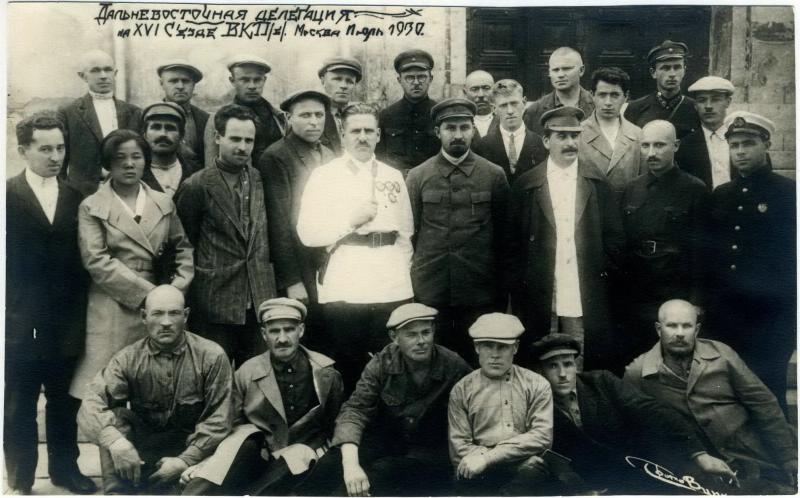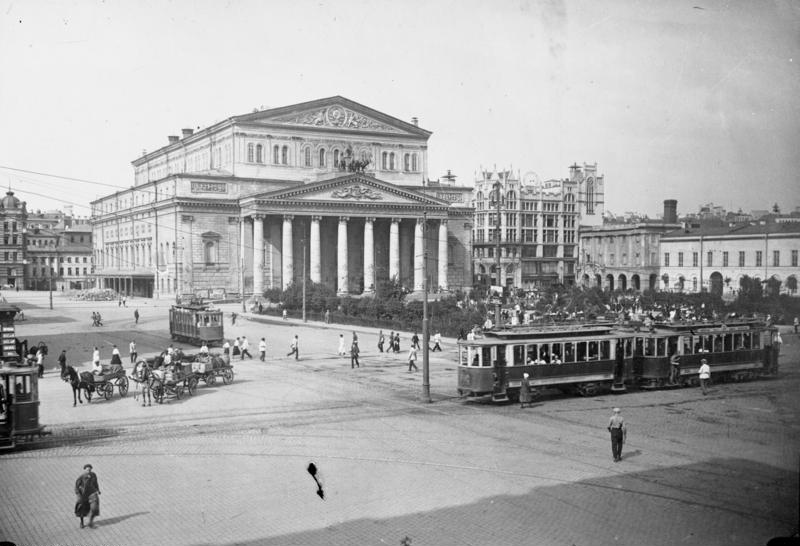|
Okhotny Ryad (metro)
Okhotny Ryad (russian: Охотный ряд) is a station on the Sokolnicheskaya Line of the Moscow Metro. It is situated in the very centre of Moscow in the Tverskoy District, near the Kremlin, Manezhnaya Square and State Duma. It is named after a nearby street, whose name literally means "hunters' row". History Okhotny Ryad station is located under what was originally the swamplands of the upper Neglinnaya River. Later two ancient churches stood on the site, and their graveyards were excavated during the construction of the station. The station opened as part of the original Metro line on 15 May 1935. Okhotny Ryad has been renamed more times than any other Metro station. Planned to be called Okhotnoryadskaya, it was opened as Okhotny Ryad instead. The station was renamed Imeni Kaganovicha in honour of Lazar Kaganovich during the brief period between 25 November 1955 and 1957, when its original name was restored. The station's name was changed once more on 30 November 1961, ... [...More Info...] [...Related Items...] OR: [Wikipedia] [Google] [Baidu] |
Moscow Metro Station
There are 250 active stations of the Moscow Metro. Of these, 209 on Moscow Metro proper, and some additional ones that are marketed by Moscow Metro: 6 stations of Moscow Monorail and 31 stations of the Moscow Central Circle. Two stations have been closed. As of 2017 several new stations are under construction or being planned. One station is reserved for future service ( Delovoy Tsentr for the Bolshaya Koltsevaya line). By number of stations the Moscow Metro is ranked 8th, cf. List of metro systems. The deepest station of Moscow Metro, Park Pobedy, is the third-deepest metro station of the world. Active stations Physical characteristics Of the Moscow Metro's 229 stations, 78 are deep underground, 109 are shallow, and 42 (25 of them on the Central Circle) are at or above ground level. Of the latter there are 12 ground-level stations, four elevated stations, and one station ( Vorobyovy Gory) on a bridge. The deep stations comprise 55 triple-vaulted pylon stations, 19 tripl ... [...More Info...] [...Related Items...] OR: [Wikipedia] [Google] [Baidu] |
Lazar Kaganovich
Lazar Moiseyevich Kaganovich, also Kahanovich (russian: Ла́зарь Моисе́евич Кагано́вич, Lázar' Moiséyevich Kaganóvich; – 25 July 1991), was a Soviet politician and administrator, and one of the main associates of Joseph Stalin. He was one of several associates who helped Stalin to seize power, demonstrating exceptional brutality towards those deemed threats to Stalin's regime and facilitating the executions of thousands of people. Born to Jewish parents in modern Ukraine (then part of the Russian Empire) in 1893, Kaganovich was the son of Moisei Benovich Kaganovich (1863-1923) and Genya Iosifovna Dubinskaya (1860-1933). Of the 13 children born to the family, 6 died in infancy. Lazar had four elder brothers, all of whom became members of the Bolshevik party. Several of Lazar's brothers ended up occupying positions of varying significance in the Soviet government. Mikhail Kaganovich (1888–1941) served as People's Commissar of Defence Industry bef ... [...More Info...] [...Related Items...] OR: [Wikipedia] [Google] [Baidu] |
Moscow Metro Stations
Moscow ( , US chiefly ; rus, links=no, Москва, r=Moskva, p=mɐskˈva, a=Москва.ogg) is the capital and largest city of Russia. The city stands on the Moskva River in Central Russia, with a population estimated at 13.0 million residents within the city limits, over 17 million residents in the urban area, and over 21.5 million residents in the metropolitan area. The city covers an area of , while the urban area covers , and the metropolitan area covers over . Moscow is among the world's largest cities; being the most populous city entirely in Europe, the largest urban and metropolitan area in Europe, and the largest city by land area on the European continent. First documented in 1147, Moscow grew to become a prosperous and powerful city that served as the capital of the Grand Duchy that bears its name. When the Grand Duchy of Moscow evolved into the Tsardom of Russia, Moscow remained the political and economic center for most of the Tsardom's history. When the ... [...More Info...] [...Related Items...] OR: [Wikipedia] [Google] [Baidu] |
Ploshchad Revolyutsii (Moscow Metro)
Ploshchad Revolyutsii (russian: Пло́щадь Револю́ции) is a station on the Moscow Metro, in the Tverskoy District of central Moscow. The station is named after Revolution Square, under which it is located. It is on the Arbatsko-Pokrovskaya Line. History When the Arbatsko-Pokrovskaya Line was first built, the tracks from Ploshchad Revolyutsii extended westward to Aleksandrovsky Sad rather than Arbatskaya. When the westward extension of the line was completed in 1953, trains were rerouted through the new segment. Architecture The station opened in 1938, its architect was Alexey Dushkin. The station features red and yellow marble arches resting on low pylons faced with black Armenian marble. The spaces between the arches are partially filled by decorative ventilation grilles and ceiling tracery. Sculptures The station contains 76 statues in the socialist realism style. Originally, 80 sculptures were created for the space—10 pairs, each replicated 4 times th ... [...More Info...] [...Related Items...] OR: [Wikipedia] [Google] [Baidu] |
Zamoskvoretskaya Line
The Zamoskvoretskaya line (russian: link=no, Замоскворе́цкая ли́ния, ), formerly Gorkovsko–Zamoskvoretskaya () (Line 2), is a line of the Moscow Metro. Opened in 1938, chronologically it became the third line. There are 24 stations on the Zamoskvoretskaya line, and it spans , roughly crossing Moscow in a north–south direction. A normal trip along the entire line takes 55 minutes, with the trains on the line averaging . While most of the line is underground, there are some pockets of surface-level or above-ground track, mainly at the point where the line crosses the Moskva River. The line contains many examples of original Moscow Metro architecture, and contains arguably the most photographed station on the entire network: Mayakovskaya. History The first stage of the line followed Moscow's busiest transport artery the Leningradsky Prospekt or as it moves into the centre the Tverskaya Street (formally Gorkovskaya hence the original name), and connected the ... [...More Info...] [...Related Items...] OR: [Wikipedia] [Google] [Baidu] |
Teatralnaya (Moscow Metro)
Teatralnaya (russian: Театра́льная, en, Theater) is an underground metro station on the Zamoskvoretskaya line of the Moscow Metro, named for the nearby Teatralnaya Square, the location of numerous theaters, including the famed Bolshoi Theatre. The station is unique in that it does not have its own entrance halls. The north escalator leads to Okhotniy Ryad and the south escalator to Ploshchad Revolyutsii. History Ploshchad Sverdlova station opened on September 11, 1938 as part of the second stage of construction of the Moscow Metro system. It was the terminal station of the Zamoskvoretskaya line until the line was extended on January 1, 1943. Teatralnaya's architect was Ivan Fomin. The station is located at a depth of 33.9 meters (111 ft). The central hall has a diameter of 9.5 meters (31 ft), with an 8.5 meter (28 ft) lateral lining of cast-iron tubing. From its opening until 1990, the station's name was Ploshchad Sverdlova, which was named in honor ... [...More Info...] [...Related Items...] OR: [Wikipedia] [Google] [Baidu] |
Revolution Square, Moscow
Revolution Square (russian: Площадь Революции, ''Ploshchad Revolyutsii'', ''Revolyutsii Square'') is a square located in the center of Moscow, in Tverskoy District, northwest of Red Square. The square has the shape of an arc running from the southwest to the north and is bounded by Manezhnaya Square to the southwest, Okhotny Ryad to the north, and the buildings separating it from Nikolskaya Street to the south and to the east. It is one of the Central Squares of Moscow. The continuation of the Revolution Square north behind Okhotny Ryad is Teatralnaya Square. There are three Moscow Metro stations located under the square, all of them having at least one exit at the square: Ploshchad Revolyutsii, named after the square, Teatralnaya, and Okhotny Ryad. All these stations are transfer stations, with Teatralnaya being connected with the other two. History Originally, the Neglinnaya River, a tributary of the Moskva River, currently underground, was flowing throu ... [...More Info...] [...Related Items...] OR: [Wikipedia] [Google] [Baidu] |
Okhotny Ryad (street)
Okhotny Ryad is a street located in Tverskoy District of Moscow. It runs from Manezhnaya Square to Theatre Square and it also lies between Georgievsky Lane and Nikolskaya Street. The numbering of houses is carried out from Manezhnaya Square. Notable buildings Okhotny Ryad is the location of the Building of Council of Labor and Defense, which has housed the State Duma since 1994, having previously housed the Council of Labor and Defense, Council of People's Commissars of the Soviet Union, Council of Ministers of the Soviet Union and Gosplan. The House of the Unions The House of the Unions (russian: Дом Союзов) (also called ''Palace of the Unions'') is a historic building in the Tverskoy District in central Moscow, Russia. It is situated on the corner of Bolshaya Dmitrovka and Okhotny Ryad streets. ... is also located on the corner of Bolshaya Dmitrovka and Okhotny Ryad streets. References Streets in Moscow {{Russia-stub ... [...More Info...] [...Related Items...] OR: [Wikipedia] [Google] [Baidu] |
Dmitry Chechulin
Dmitry Nikolaevich Chechulin (russian: Дми́трий Никола́евич Чечу́лин; , in Shostka – 29 October 1981, in Moscow) was a Russian Soviet architect, city planner, author, and leading figure of Stalinist architecture. Life Born in Shostka (Sumy Oblast, today in Ukraine) to a working-class family, after service in the Red Army Chechulin enrolled in the state school Vkhutemas and graduated in 1929, doing post-graduate work under Alexey Shchusev. In the 1930s Chechulin was awarded commissions for four stations of the Moscow Metro, and developed his career to design a list of familiar Moscow landmarks. From 1945 through 1949 he served as chief architect of Moscow. Chechulin's work intersects with the Palace of the Soviets competition (the major event in Soviet architectural history) at multiple points. He was among the twelve finalists in the final round. He is credited for the Kotelnicheskaya Embankment Building, one of the seven Moscow ''vysotki'' (tal ... [...More Info...] [...Related Items...] OR: [Wikipedia] [Google] [Baidu] |
Theatre Square (Moscow)
Theatre Square or Teatralnaya Square (russian: Театральная площадь, ''Teatralnaya ploshchad''), known as Sverdlov Square between 1919 and 1991, is a city square in the Tverskoy District of central Moscow, Russia. It is at the junction of Kuznetsky Bridge Street, Petrovka Street, and Theatre Drive (north-west of the latter; the square south-east of Theatre Drive is the separate Revolution Square). The square is named after the three theatres located on it: the Bolshoi Theatre, Maly Theatre, and Russian Academic Youth Theatre. The square is served by the Moscow metro at the Teatralnaya station on the Zamoskvoretskaya Line; Okhotny Ryad station on the Sokolnicheskaya Line; and Ploshchad Revolyutsii station on the Arbatsko-Pokrovskaya Line. History The square emerged after the 1812 Fire of Moscow and conversion of the Neglinnaya River into an underground channel. The river still flows diagonally under the square's park. It was designed in a symmetrical ... [...More Info...] [...Related Items...] OR: [Wikipedia] [Google] [Baidu] |
Plaster
Plaster is a building material used for the protective or decorative coating of walls and ceilings and for Molding (decorative), moulding and casting decorative elements. In English, "plaster" usually means a material used for the interiors of buildings, while "render" commonly refers to external applications. Another imprecise term used for the material is stucco, which is also often used for plasterwork that is worked in some way to produce relief decoration, rather than flat surfaces. The most common types of plaster mainly contain either gypsum, lime plaster, lime, or cement plaster, cement,Franz Wirsching "Calcium Sulfate" in Ullmann's Encyclopedia of Industrial Chemistry, 2012 Wiley-VCH, Weinheim. but all work in a similar way. The plaster is manufactured as a dry powder and is mixed with water to form a stiff but workable paste immediately before it is applied to the surface. The reaction with water liberates heat through crystallization and the hydrated plaster then ha ... [...More Info...] [...Related Items...] OR: [Wikipedia] [Google] [Baidu] |
.jpg)





